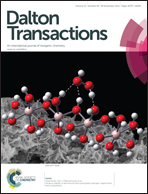Blue-shift of Eu2+ emission in (Ba,Sr)3Lu(PO4)3:Eu2+ eulytite solid-solution phosphors resulting from release of neighbouring-cation-induced stress†
Abstract
A series of iso-structural eulytite-type (Ba,Sr)3Lu(PO4)3:Eu2+ solid-solution phosphors with different Sr/Ba ratios were synthesized by a solid-state reaction. Crystal structures of (Ba,Sr)3Lu(PO4)3:Eu2+ were resolved by the Rietveld method, which shows an eulytite-type cubic Bi4(SiO4)3 structure with cations disordered in a single C3 site while the oxygen atoms were distributed over two partially occupied sites. The emission peaks of Ba(3−x)SrxLu(PO4)3:Eu2+ (0 ≤ x ≤ 3) phosphors were blue-shifted, from 506 to 479 nm, with increasing Sr/Ba ratio upon the same excitation wavelength of 365 nm, and such interesting luminescence behaviours can also be found in other eulytite-type (Ba,Sr)3Ln(PO4)3:Eu2+ (Ln = Y, Gd) solid-solution phosphors. The blue-shift of the Eu2+ emission with increasing Sr/Ba ratio was ascribed to the variation of the crystal field strength that the 5d orbital of Eu2+ ion experiences, and a new model based on the Eu–O bond length and released neighboring-cation stress in disordered Ba2+/Sr2+/Ln3+ sites is proposed.



 Please wait while we load your content...
Please wait while we load your content...